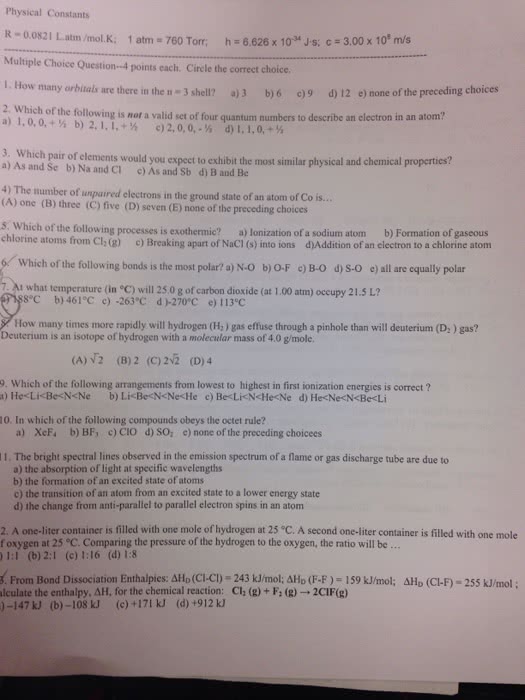CHEM 101 Midterm: CHEM 101 Drexel CHEM 101 MAKE UP Exam Fall 2009 with answer key
Page 1 of 5
CHEM 101 Fall 09 Make-Up Exam (a)
On the answer sheet (scantron) write your name, student ID number, and recitation section
number. Choose the best (most correct) answer for each question and enter it on your answer
sheet. Potentially useful data: R = 0.08206 L·atm·mol-1·K-1
1 atm = 760 Torr = 760 mm Hg
Avogadro’s number: 6.022 x 1023
1. Please choose the letter “a” as your answer for this question.
2. A list of non-metals is given below. Which elements cannot normally exceed the octet rule?
B Si N P O S F Cl
a.
Si, P, S, Cl
b.
B, N, O, F
c.
O, S, F, Cl
d.
B, Si, N, P
e.
All eight elements can exceed the octet rule.
3. Construct correct Lewis dot structures for the three molecules below. Determine which
compounds exceed the octet rule.
PF3 SF4 O3
I II III
a.
I
b.
II
c.
III
d.
II and III
e.
I, II, and III
4. VSEPR Theory attempts to __________ electron-pair __________.
a.
eliminate, attractions
b.
minimize, collisions
c.
minimize, repulsions
d.
maximize, attractions
e.
maximize, repulsions
5. Which statement about a central atom that has six electron pairs is false?
a.
The central must have an expanded octet.
b.
The central atom can be a nonmetal.
c.
The central atoms must be from the third or subsequent periods.
d.
The central atom can be a transition metal.
e.
The central atom must have an octahedral molecular geometry.

Page 2 of 5
6. According to VSEPR theory, if there are three electron domains around a central atom of a
molecule, they will be arranged in a(n) __________ geometry.
a.
octahedral
b.
linear
c.
tetrahedral
d.
triangular (or trigonal) planar
e.
triangular (or trigonal) bipyramidal
7. Use VSEPR Theory to predict the electron-pair geometry, the molecular geometry, and the
H-N-H bond angle for NH3.
a.
square planar, square planar, 90
°
b.
tetrahedral, triangular (or trigonal) pyramidal, 109.5
°
c.
tetrahedral, square planar, 109.5°
d.
triangular (or trigonal) bipyramidal, tetrahedral, 90
°
e.
tetrahedral, tetrahedral, 109.5
°
8. For which of the following molecules will the electron-pair geometry be different than the
molecular geometry?
a.
NH4+
b.
CO
c.
CH4
d.
BH3
e.
H2O
9. Using VSEPR Theory, predict the molecular geometry of XeF2.
a.
linear
b.
bent
c.
tetrahedral
d.
triangular (or trigonal) bipyramidal
e.
T-shaped
10. Which molecule is polar?
a.
BF3
b.
H2Se
c.
N2
d.
GeF4
e.
CO2
11. Which molecule below has only London (or dispersion) intermolecular forces?
a.
HF
b.
OF2
c.
PF3
d.
CCl4
e.
CH3Cl

